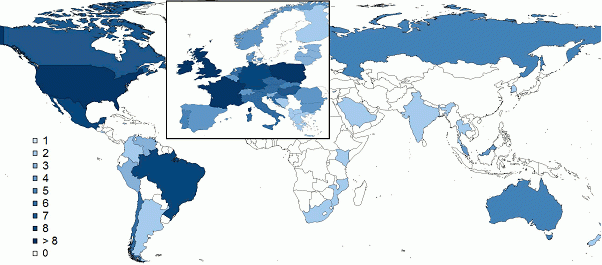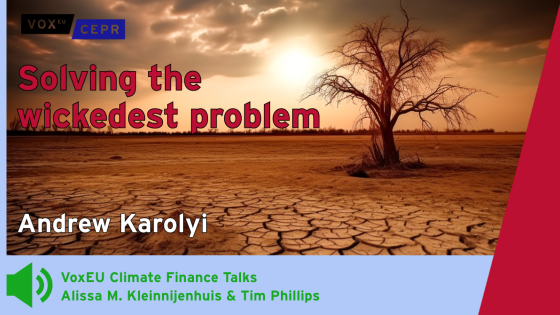Multinational banks across the world, but in particular in Europe, are experiencing severe balance-sheet pressures. Barely recovered from the 2008–09 subprime crisis, asset quality is now battered by banks’ exposures to sovereign risk in the Eurozone periphery. The European Banking Authority has consequently instructed EU banks to for the time being increase core Tier 1 capital to 9% by mid-2012 (EBA 2011). In addition a temporary sovereign risk charge will be in force. This means that banks either have to raise a substantial amount of new equity, not easy in the current climate, or will – under quit strict regulatory guidance – reduce their risk-weighted assets (that is, to deleverage). To make matters worse, international banks are also experiencing difficulties in rolling over maturing bonds. This may further constrain their ability to lend, both at home and abroad.
What does this imply for the host countries where these banks are operating branches and subsidiaries? This column presents the results of our recent working paper (De Haas and Van Lelyveld 2011) in which we compare the lending of standalone domestic banks with lending by multinational bank subsidiaries. We focus on the 2008–09 financial crisis, the previous ‘perfect storm’ that hit multinational banks.
Global versus local
Our analysis is a follow-up to De Haas and Van Lelyveld (2010) where we used similar data to examine bank lending during earlier and more contained bouts of financial turmoil. At the time we found that during such local crises, subsidiaries of financially strong parent banks typically did not rein in their lending whereas domestic banks had to do so. Strong parent banks can use their internal capital market to provide subsidiaries with capital and liquidity and such financial support has helped stabilise local lending.
The 2008–09 crisis, which struck at the core of the international financial system and affected virtually all large banking groups, clearly calls for a reappraisal of this evidence. Just as strong parent banks supported subsidiaries during local crises, weak parent banks may have discontinued such support during the global crisis. Weakened parent banks, hit by a reduction in interbank liquidity and other funding, may even have used their internal capital market to repatriate funds from subsidiaries to headquarters. Indeed, according to publications in the business press, multinational bank subsidiaries in Russia and the Czech Republic used local liquidity to support their foreign headquarters in Italy and France in the wake of the Lehman Brothers collapse as well as during the current euro crisis (see for example Cotterill 2011).
To analyse these issues, we create a comprehensive dataset on the world’s largest multinational banking groups as well as a benchmark group of standalone domestic banks. Figure 1 provides a geographical representation of our sample of multinational bank subsidiaries. It consists of 48 multinational banks from 19 home countries with 199 subsidiaries across 53 countries. Most parent banks and subsidiaries are based in Europe, reflecting the numerous ownership links between western European banks and their subsidiaries in emerging Europe.
Figure 1. Geographical location of multinational bank subsidiaries
Note: Darker colours indicate a larger number of subsidiaries in a country. Source: BankScope and banks’ web sites.
We also create a benchmark group of domestic banks that consists of the five largest domestically owned banks in each of the host countries in our dataset. This results in a sample of 202 domestic banks.
Multinational banking: a double-edged sword
Our analysis reveals that multinational bank subsidiaries had to curtail credit growth more aggressively than domestic banks – about twice as much – during the recent crisis. We also find that access to deposits, a relatively stable funding source during the crisis, became a stronger determinant of credit growth. Domestic banks, which tend to rely more on local deposits to fund credit growth, were therefore better positioned to continue to lend.
The relative increase in the importance of deposits as a funding source was particularly high for multinational bank subsidiaries. Such subsidiaries typically have better access to alternative (foreign) funding sources, such as the international bond and syndicated loan markets as well as parent-bank funding. However, when such alternative funding dried up, these banks had to reduce lending more. Indeed, we find that those subsidiaries of parent banks that relied to a greater extent on wholesale funding had to slow down credit growth the most. Parent banks that could not access external (wholesale) markets were apparently no longer in a position to allocate liquidity to their subsidiary network via the group's internal capital market. This finding is in line with Huang and Ratnovski (2009) who focus on the funding structure of Canadian banks and show that a lower share of wholesale funding in total liabilities made bank lending more resilient during the recent crisis.
In all, we conclude that while multinational banks may contribute to financial stability during local bouts of financial turmoil, as shown in De Haas and Van Lelyveld (2010), they also increase the risk of ‘importing’ instability from abroad. Foreign bank subsidiaries' access to parent and wholesale funding, one of their main competitive advantages before the crisis, turned out to be a mixed blessing when these alternative funding sources dried up after the Lehman Brothers collapse. Banks' excessive reliance on wholesale funding may have negative effects on financial stability, both at home and abroad.
Outlook
Our findings do not bode well for countries whose banking systems are to a large extent owned by multinational banking groups. The funding pressures that many of these banking groups are currently experiencing may be more severe than they were three years ago. The urge to deleverage will therefore be higher too. An important risk is that banks may feel pressure to let this deleveraging take place abroad rather than at home.
In the medium term, many multinational bank subsidiaries, in particular in emerging Europe, will have to revise their funding models. They will increasingly have to stand on their own financial feet, raising local deposits and other local funding to finance their local lending. The 2008–09 crisis has shown that multinational bank subsidiaries that fund themselves more in local markets, such as many subsidiaries in Latin America, are relatively stable lending sources.
Supervisors could encourage multinational banks to gradually move towards such more sustainable funding models. Prudential limits on subsidiaries’ foreign funding (ie, partial ‘ring-fencing’) may cushion the cross-border transmission of financial shocks going forward. However, supervisory authorities should also be careful not to overreact. Uncoordinated and too heavy-handed regulatory actions could interfere with multinational banks’ efforts to support their foreign subsidiaries and could unduly exacerbate multinational banks’ home bias in the short term. Such uneven deleveraging would put further pressure on economic growth across large parts of emerging Europe.
References
Cotterill, Joseph (2011), “Honey, I shrunk Emerging Europe”, ft.com/alphaville, 4 November.
De Haas, R and . Van Lelyveld (2010), “Internal Capital Markets and Lending by Multinational Bank Subsidiaries”, Journal of Financial Intermediation 19(1): 1–25.
De Haas, R and I Van Lelyveld (2011), “Multinational Banks and the Global Financial Crisis: Weathering the Perfect Storm”, EBRD Working Paper No. 135, European Bank for Reconstruction and Development, London.
Huang, R and L Ratnovski (2009), “Why Are Canadian Banks More Resilient?”, IMF Working Paper WP/09/152, International Monetary Fund, Washington, D.C.




